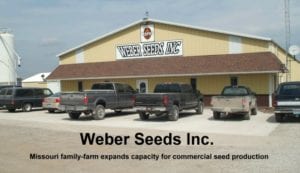
DAN WEBER, PRESIDENT
In 2009, the USDA projects that Missouri’s harvested soybean acres will rank fifth in the nation. Much of that crop is produced in Missouri’s boot-heel region along the Mississippi River.
Another pocket of concentrated soybean production is located in Saline, Carroll, Chariton, and Lafayette counties about 75 miles east of Kansas City, MO. Here in central Saline County is where Weber Seeds is located.
“We are somewhat isolated from the rest of Missouri’s soybean production,” says President Dan Weber, Weber Seeds Inc. “The farmland along the Missouri River through this area combined with our local weather pattern is well suited to soybean production.”
For nearly 50 years, the Weber family’s diversified 10,000 acre farm has been producing certified soybean seed along with commercial corn and wheat.
“Sometime in the 1960’s our father setup a Clipper fanning mill in the old chicken house and began selling certified public soybean and wheat seed,” Weber recalls. “Since that time, our seed business has continued to expand with our own private brand and more wholesale production.”
As the private brands began to erode the market for public varieties in the 1980s, Weber Seed introduced its own brand of soybean seed, Willcross. In 1991, Weber Seeds incorporated as the company expanded its retail sales. The advent of biotech soybean traits in 1996 further changed the soybean seed industry and gave Webers reason to reevaluate their position in the industry. New Seed Facility “Looking ahead, we realized that to invest in a new facility would require us to change our business model,” Weber says. “To support the kind of a forward- looking, high-quality facility we envisioned, we knew we would need to expand our seed production.” Working with Popp Engineering, Ames, IA, plans for a new facility were made. Construction began in 2008 and was completed in time to process 100,000 units of 2009-crop wheat seed. Designing the new facility was a cooperative effort, Weber says. After initial discussions and consultations, Popp Engineering presented a design proposal.
Weber and his staff worked with President Jon Popp to arrive at a final plan. “Every facility has its individual needs, requirements and design challenges,” says Popp. “The staff at Weber had done their homework. They knew what they wanted and we were able to accommodate their ideas into the final plan.” Oil Dust Suppression One of the features of the new Weber Seeds facility is the use of mineral oil for dust suppression. As the seed is conveyed from the Westrup airscreen, it receives a stream of white mineral oil. The oil mixes with the seed as it moves through seed ladders on its way to the gravity separators. Widely used in the grain industry, oil dust suppression is rare in the seed industry.
Suppliers List
- Facility design
- Popp Engineering, Inc., Ames, IA,
- Automation/Controls ….. Otis & Associates ………………….
Popp Engineering
- Airscreen cleaner …………….. Westrup A/S
- Bag placer ………………….. Chantland-MHS
- Baggers, bulk bags ……….. Chantland-MHS
- Bagger, open mouth ……… Chantland-MHS
- Bucket elevators…….. Universal Industries Inc.
- Conveyers ……………… Chantland-MHS
- Dust collection ………. Donaldson Torit
- Dust suppression …. Popp Engineering
- Gravity separator …………. Oliver Mfg.
- Heat sealer …………………… Fischbein
- Inkjet bag lip printer …………… Marsh
- Inline storage .. Popp Engineering Inc.
- Letdown ladders …… Northland Design
- Level indicators …………….. BinMaster
- Robotic palletizer ….. Fanuc Robotics
- Robotic programming ………….. PASCO
- Seed treater …………. Bayer/Gustafson
- Valve gates ……Popp Engineering Inc.
- Vibratory conveyor ….. Forsbergs Inc.
“The biggest challenge is to meter the correct amount of oil onto the seed,” says Popp. “Too much oil is worse than none: the seeds stick together, get stuck on elevator buckets and impairs seed treatments. With too little oil, the treatment becomes ineffective. The secret is to get the seed as clean as possible before adding oil.” In addition to calibration, Popp Engineering also devised a seed sensor to coordinate oil application with the presence or absence of seed on the conveyor. The effectiveness of oil suppression is evidenced by the lack of hoods on the Oliver gravity separators. Normally, large hoods and high volumes of air are required to contain the dust from these machines. Popp calculates that the elimination of hoods over the gravity separators reduces the size of the dust collection system by 68 percent.
All the air through the dust collection system is exhausted into the building, not to the outside. During the colder months of the year, the facility essentially heats itself. For Plant Manager E.W. Browning, ease of operation is an important feature. Most equipment is on ground level or on a low-level mezzanine. “You don’t spend a lot of time and energy going up and down stairs to monitor this operation. Everything is easily accessible,” he says. Flexibility is another feature of the facility, Browning says. Popp’s design allows seed to bypass any process that is not needed. Equipment Highlights Weber says that to date, a color sorter has not been required by any of his customers. In anticipation of future needs, however, the facility is fully piped and ready to have a color sorter installed. A Gustafson seed treater provides capability to apply virtually any compatible seed treatment. The majority of the seed conditioned by Weber Seeds is packaged in valve-top bulk bags. Seed can be packaged by either weight or count. Single unit bags are either heat sealed pinchto- close or sewn bags. “With the Fanuc robotic palletizer, the heat sealed pinch-to-close bags make a very sharp and clean pallet,” says Browning. “After they are stretch wrapped, those pallets are as solid as a brick.” Weber’s warehouse capacity was expanded to over 100,000 sq. ft. with the 2009 addition of a 85-ft. x 300- ft. multipurpose storage building. “With this new facility, we have complete control of seed quality from planting through harvest, conditioning, treating, packaging, and storage,” Weber says. “Compared to the multinational companies, we are a smaller company, but small does not mean reduced quality,” he says. “On the contrary, because we are small, we personally manage our seed throughout the entire process. The quality of our product is equal to or better than that of any of our competitors.”
Joe Funk, editor
